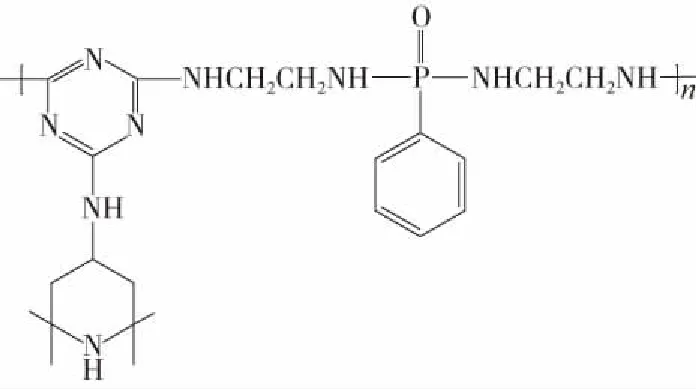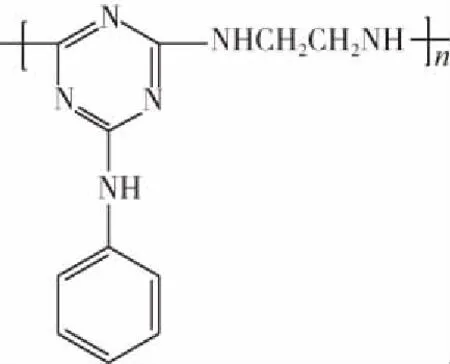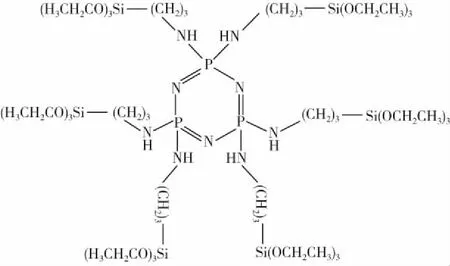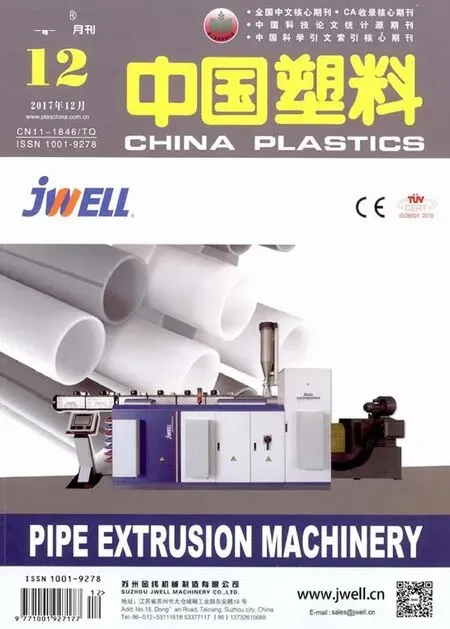元素杂化阻燃聚丙烯的研究进展
倪恒健,万晓明,王文华,郭军红,杨保平,崔锦峰
(兰州理工大学石油化工学院,甘肃 兰州 730050)
0 前言
高分子材料的阻燃性、热稳定性和燃烧性能是影响其应用的3个关键因素。PP作为五大通用塑料之一,具有良好的力学性能、耐化学腐蚀性、密度低、毒性低等优点,且成本低、易加工,在汽车、电缆、包装、建材等领域中具有广泛应用[1-6]。然而PP中含有大量的甲基基团,导致其极限氧指数只有17.4 %,属于易燃高分子材料,抑制了其进一步应用[7-9]。此外,PP燃烧时产生黑烟、有毒气体并伴随有熔滴滴落,对人们的生命健康财产带来巨大的威胁。因此,提高PP的阻燃性能已成为世界各国急需解决的热门课题之一[10]。
目前对PP的阻燃研究,研究学者们主要将阻燃剂通过熔融共混法引入PP基体材料中,提高PP的阻燃性、热稳定性、降低其易燃性。本文主要介绍了单元素阻燃、多元素协同阻燃及生物基阻燃剂阻燃PP的研究进展及目前存在的问题。
1 PP的燃烧机理及阻燃措施

阻燃PP最根本的方法是切断燃烧3要素[13],所以可以使用以下3种措施进行阻燃。(1)气相阻燃。终止自由基链反应:分解阶段产生高活性的·H和·OH自由基,使燃烧链式反应无法持续进行下去,切断自由基链式反应即达到阻燃的效果,卤素和磷元素可以达到此效果;稀释作用:不燃性气体稀释可燃性气体的浓度。(2)凝聚相阻燃。聚合物燃烧在其表面形成一层致密的阻隔层,阻止质量传递与热量传递、抑烟、防熔滴。如膨胀型阻燃剂(IFR),可形成连续致密的膨胀炭层[14-15]。(3)中断热交换阻燃。在着火阶段产生的热量持续反馈给材料,引入高热容量的阻燃剂即可吸收大量的热量,最终维持燃烧的热量不足而停止燃烧,氢氧化铝(ATH)和氢氧化镁(MH)是目前的最佳选择。
目前,阻燃剂加入PP中有2种方式:一是将阻燃剂机械混合到PP中,这是目前制备阻燃PP的主要方法;二是将阻燃剂通过化学反应接枝到PP的主链或侧链上,使PP本征阻燃。
2 元素杂化研究进展
2.1 卤素阻燃
卤素阻燃剂主要发挥气相阻燃的作用:卤素在燃烧过程中生成的卤化氢捕获·H和·OH自由基,生成低活性的·X,从而减缓甚至终止燃烧链式反应[式(1)、式(2)][16]。还有研究较少的凝聚相阻燃作用[17]:某些卤化物在高温下释放卤和卤化氢后,在凝聚相形成的物质可以进一步环化和缩合为类焦炭残余物,作为保护屏障。

(1)
(2)
随着国际环保部门呼声的日益高涨,卤素由于发烟量大、对人类和动物的影响持久、生物蓄积性、致癌和有毒而逐步淡出阻燃PP领域,早年研究较多的是将三氧化二锑(Sb2O3)或纳米复合材料与卤素阻燃剂复配提高阻燃效率。
2.2 氮元素阻燃
氮系阻燃剂是指三嗪类化合物,主要包括三聚氰胺(MEL)及其衍生物等。它们在燃烧过程中升华、挥发、分解会吸收大量的热量,生成MEL蒸气、水蒸气、N2、CO2、NH3等不可燃气体,从而起到气相阻燃的作用。
Wen等[18]合成了一种新型三嗪基聚合物(TBMC),化学结构如图1所示,从PP/聚磷酸铵(APP)/TBMC复合材料燃烧后的残炭扫描电子显微镜(SEM)照片中可以看出(图2),形成了连续致密的炭层,改善了PP的阻燃性能。此类阻燃剂具有无毒、低烟、无卤、无腐蚀性气体产生等优点,但其阻燃效率低。目前研究学者主要将其作为IFR中的气源,发挥氮元素的绝对优势,从而达到协同阻燃的作用。

图1 TBMC的结构示意图Fig.1 Structure of TBMC
2.3 磷元素阻燃
磷元素兼具有气相和凝聚相的阻燃机理:PO·自由基捕获气相中高活性的·H和·OH自由基;生成的聚偏磷酸使聚合物脱水成炭,覆盖在材料表面,阻隔了质量传递和热量传递。磷系阻燃剂包括无机磷(如红磷、APP等)和有机磷(如磷酸酯、亚磷酸酯等)。

(a)PP1 (b)PP2 (c)PP6图2 PP/APP/TBMC复合材料残炭的SEM照片Fig.2 SEM of char residues of PP/APP/TBMC composites
红磷由于有颜色、易氧化、加工时生成磷化氢(PH3)有毒气体等缺点,近些年来微胶囊化红磷(MRP)赋予了红磷广阔的应用前景。刘亚青等[19]制备了膨胀型红磷微胶囊阻燃剂,系统研究了其阻燃机理,并对阻燃PP的燃烧行为与力学性能进行了分析。Lin等[20]将APP用γ - 氨丙基三乙氧基硅烷(KH-550)进行表面改性后加入PP中。结果表明,处理后的APP在PP中的分散性及相容性得到了明显改善,同时提高了PP/APP的力学性能。加入30 %(质量分数,下同)的APP时,PP的极限氧指数提高到30 %。Wang等[21]使用三聚氰胺甲醛树脂(MF)包覆APP形成的微胶囊化聚磷酸铵(MCAPP),具有比APP更好的耐水性,且提高了PP的力学性能和阻燃性能。Liu等[22]使用KH-550和硅树脂改性APP得到了改性聚磷酸铵(MAPP),水接触角为148 °,证实了MAPP具有优异的疏水性能。
磷系阻燃剂的阻燃效果好、无污染,但在基体中具有分散性差、相容性差、耐水性差、阻燃效率低等缺点。所以目前研究的主要是改性的磷系阻燃剂以及复配阻燃体系,以提高其耐水性、相容性和阻燃效率。
2.4 硅元素阻燃
硅系阻燃剂有无机硅和有机硅,无机硅和有机硅中研究最多的分别是蒙脱土和聚硅氧烷。高温下,其分解生成的二氧化硅(SiO2)具有较低的表面能,迁移到材料表面保护了聚合物材料,从而达到良好的阻燃效果[23]。
对PP而言,目前美国通用电气公司生产的SFR-100和SFR-1000是较为经济有效的含硅阻燃剂[24]。以SFR-100为阻燃剂,当其含量为25 %时,阻燃等级达到UL 94 V-0级,并能保持PP原有的性能,若再提高SFR-100的含量可获得抑烟性和更加优异的阻燃性能。
当硅与其他元素复配使用时,可以获得更好的阻燃效果,所以研究方向转到P—Si、N—Si、P—N—Si、P—N—C—Si等元素的协同阻燃上。
2.5 铝、镁元素阻燃
作为阻燃的铝、镁元素主要以ATH、MH的形式存在,在聚合物中达到阻燃、抑烟、填充剂的效果,适用于加工温度高的聚合物。ATH、MH在燃烧过程分解产生的水,吸收了大量的热量,继而转化为水蒸气又稀释了可燃性气体的浓度;同时脱水生成的氧化物覆盖在聚合物基体表面,阻止了基体材料进一步分解的同时又具有抑烟的功效。
朱鹏等[26]使用MF包覆经过表面改性的ATH制备出的微胶囊化ATH,作为PP阻燃剂时,促进了致密炭层的形成。刘延雷等[27]制备出表面改性超细MH阻燃剂。以上处理的ATH和MH表现出良好的阻燃效果,且对PP力学性能的影响很小。
对于上述2种阻燃剂,想要达到理想的阻燃效果,需要添加的量多,分散性及相容性差,导致材料的力学性能急剧降低,限制了其应用。针对ATH和MH,目前主要进行界面改性、微胶囊化、超细化和作为协效剂,以期降低添加量、提高相容性以及改善力学性能。
2.6 硼元素阻燃
硼系阻燃剂主要是硼酸锌(ZB),具有无毒、低水溶性、高热稳定性、粒度小、比重小、分散性好等优点,被广泛用作聚合物的阻燃剂。ZB的结构有多种,其中3ZnO·5B2O3·14H2O的阻燃效果最好,其阻燃机理如图3所示,3ZnO·5B2O3·H2O在高温下稳定,覆盖在基体材料表面,起到隔绝氧气与屏蔽挥发性可燃气体的效果,阻止了炭层的进一步氧化并促进成炭的形成[28]。

图3 ZB的转变过程
Feng等[29]研究了ZB对PP/IFR复合材料阻燃性能的影响。结果表明,少量的ZB能有效提高复合材料的极限氧指数和垂直燃烧实验中的UL 94等级。另外ZB不仅能促进致密均匀炭层的形成,还能改变IFR与PP/IFR的降解行为,提高高温下PP/IFR体系的热稳定性和残炭率,说明ZB是一种高效的协效剂。
对于硼系阻燃剂,目前的研究主要集中于其作为阻燃协效剂方面[30]。
3 元素协同阻燃
元素杂化阻燃研究进展中其实还包括很多少见的元素,但是单独使用某种阻燃元素的化合物,在阻燃效果上不尽人意,所以多元素协同阻燃得到了越来越多研究人员的关注。
3.1 磷 - 氮协同阻燃
磷 - 氮元素是最经典的协同阻燃体系,磷元素主要在凝聚相发挥作用,氮元素则在气相发挥作用的同时还可以作为炭层的发泡剂。两者一起使用能够促进炭层的膨胀,提高复合材料的阻燃性能。
Duan等[31]制备了磷 - 氮超支化聚合物(PN-HBP),与APP复配进行阻燃PP的研究,拉曼光谱测试说明PN-HBP和APP的结合可以促进石墨化炭层的形成,表明两者之间存在协同阻燃效果。Xu等[32]使用六氯环三磷腈(HCCP)和4,4′ - 二羟基二苯砜(BPS)可以在α - 磷酸锆(α-ZrP)表面促进交联反应,制备出一种功能化α-ZrP(FZ)。聚磷腈与α-ZrP之间存在协同阻燃机理:燃烧初期,涂层分解消除PP链断裂的自由基,在后期α-ZrP表面固体酸位点促进成炭,从而在基体上产生连续致密的膨胀炭层。
目前磷 - 氮协同阻燃体系是阻燃界的研究热点,但现在已经不是单纯的合成含磷 - 氮的小分子化合物,而是转向合成磷 - 氮高分子低聚物、磷 - 氮超支化聚合物、IFR或者引入协效剂等方向。
3.2 磷 - 硅协同阻燃
近些年来,研究人员也研究了磷 - 硅2种元素协同阻燃的效果。Huang等[33]合成了含有P—O—Si键的阻燃剂聚笼状季戊四醇双磷酸二苯基硅二醇酯(SDPS)。结果表明,PP/三聚氰胺聚磷酸盐(MP)/SDPS与PP/MP和PP/SDPS相比,极限氧指数提高到31.4 %。垂直燃烧实验、热失重分析(TG)、热重 - 红外联用(TG-FTIR)分析结果均证明了SDPS与MP存在协同阻燃作用:在MP作为酸催化剂的存在下,催化断裂了P—O—Si键,从而促进炭和SiO2的形成。
3.3 磷 - 氮 - 碳协同阻燃
IFR具有无毒、抑烟、抗熔滴、环境友好等优点,被认为是最具有发展前途的无卤阻燃剂[34-36]。IFR中碳源、气源为协效剂,酸源为阻燃剂。其中碳源是形成膨胀层的基础,主要是一些含碳量高的多羟基化合物[37-39]。最典型的IFR体系是APP/季戊四醇(PER)/MEL,但是由于该体系中的物质都是小分子,所以形成的炭层松散、脆弱,导致阻燃效果不理想[40-41]。
Xie等[42]合成出一种具有自由基淬灭能力的大分子成炭剂聚[N - (2,2,6,6 - 四甲基哌啶) - 1,3,5 - 三嗪 - 2 - 胺 - N,N′ - 二(2 - 氨乙基) - 苯基磷酸酯](HAPN),分子结构如图4所示,对其与APP复配阻燃PP进行了研究。结果表明,当APP/HAPN含量为25 %,APP与HAPN的添加量相等时,极限氧指数达到最高值(29.5 %),垂直燃烧测试达到UL 94 V-0级,在点燃后36 s内可以自熄。与此同时,热释放速率峰值、热释放总量、平均热释放速率和平均质量损失速率均显著降低。Feng等[43]也分别合成了大分子成炭剂聚(N - 苯基 - 1,3,5 - 三嗪 - 2 - 胺 - 4,6 - 二氯乙二胺)(CNCA-DA),分子结构如图5所示,制备了PP/APP/CNCA-DA复合材料。结果表明,当APP/CNCA-DA含量为30 %,APP和CNCA-DA的质量比为2∶1时,极限氧指数高达35.6 %,属于难燃级别,阻燃效果最佳。锥形量热仪(CCT)测试表明APP/CNCA-DA可以改变PP的热分解行为并在复合材料表面形成炭层,有效地降低了热释放速度峰值、热释放总量、烟释放速率、总烟释放量和质量损失。

图4 HAPN的结构示意图Fig.4 Structure of HAPN

图5 CNCA-DA的结构示意图Fig.5 Structure of CNCA-DA
Zheng等[44]将IFR与膨胀石墨(EG)复配来提高PP的阻燃效率。PP/IFR/EG复合材料在800 ℃的理论残炭率为7.42 %,而实际残炭率为11.35 %,提高了3.93 %,证明了IFR与EG之间存在协同阻燃作用。Zhang等[45]研究了醋酸钴(CoAc)、醋酸锰(MnAc)、醋酸镍(NiAc)、醋酸锌(ZnAc)作为增效剂时,对PP/IFR复合材料的影响,结果表明,适量金属醋酸盐的添加能有效提高PP/IFR复合材料的阻燃性能。Ye等[46]制备了PP/IFR/含钴有机无机杂化材料[Bmim]6CoW12O40(CoW)复合材料,SEM和CCT测试结果表明,CoW的存在提高了炭层的质量以及成炭速率。Gao等[47]研究了聚硅氧烷对PP/IFR复合材料性能的影响,结果表明,聚硅氧烷有效提高了PP/IFR复合材料的高温热稳定性、残炭率,降低了可燃性,另外聚硅氧烷还明显改善了IFR的耐水性。
传统的IFR体系存在很多缺点,除了合成新型低吸水性成炭剂、加入协效剂,还有表面改性、微胶囊包覆、“三位一体”的IFR,以此来减少添加量、降低吸水性、提高相容性、提高热稳定性和阻燃性。
3.4 磷 - 氮 - 硅协同阻燃
研究发现,磷 - 氮 - 硅具有协同阻燃的效应[48]。此类阻燃剂在燃烧过程中具有低烟、低毒特性,是一种环境友好型阻燃剂。
Qin等[49]合成了含硅环三磷腈六{N-[3-(三乙氧基硅基)丙基]}环三磷腈(APESP),分子结构如图6所示,并对PP/APP/APESP复合材料进行了研究。结果表明,APP/APESP能显著降低复合材料的可燃性,且复合材料的流变行为和脆性断口形貌分析证明了其力学性能的提高。同时对不同成分的混合能量和Huggins参数的模拟计算,证明了APESE提高了APP和PP基体间的相容性。

图6 APESP的结构示意图Fig.6 Structure of APESP
3.5 磷 - 氮 - 碳 - 硅协同阻燃
在磷 - 氮 - 硅3种元素协同阻燃的基础上,研究人员又进行了磷 - 氮 - 碳 - 硅4种元素的协同阻燃研究,同样也取得了优异的阻燃效果。
Song等[50]利用废硅油(主要成分为CxHySizCln)与1 - 氧代 - 4 - 羟甲基 - 1 - 磷杂 - 2,6,7 - 三氧杂双环(PEPA)反应合成磷硅杂合物(SPH),制备了PP/SPH/MP/PER复合材料。SPH/MP/PER改善了PP的阻燃性能,可能是由于硅在稳定碳质层中起到重要作用,更重要的是SPH具有低成本和极佳的环保价值,使得废硅油具有了新的利用价值。
3.6 其他协同阻燃体系
除了上述常见的协同阻燃体系,还有一些元素间的协同阻燃体系。Lai等[51]研究了聚硼硅氧烷(PBSil),与ZB、沸石和SiO2相比,PBSil在PP/IFR中具有更好的抑烟性、阻燃性。Kong等[52]制备了PP/MH/铁蒙脱石(Fe-MMT)纳米复合材料,Jiao等[53]制备了PP/IFR/铁酸镧(Fe-La2Sn2O7)复合材料,均取得了良好的阻燃效果。
4 生物基阻燃剂
近些年来,阻燃剂的毒性、环境影响持久性和生物积累引起了人们的广泛关注。尝试制定完善的绿色阻燃材料战略,生物基阻燃剂是最环保的替代品,但许多天然资源的热稳定性较差。因此,需要对生物原料的性能进行改性,以满足聚合物材料加工的要求。如Wang等[54]将一磷酸腺苷(AMP)嵌入MF主链形成功能性微球(MFA),提高了AMP的热稳定性,达到了PP的加工温度要求。Das等[55]将生物炭通过熔融共混的方式加入到PP中,并对其进行了表征分析。结果表明,随着高比表面积生物炭含量的增加,PP的力学性能提高,且复合材料的热释放速率峰值和总烟释放量明显降低;具有热稳定性的生物炭提供一个致密的炭层,阻止了质量传递和热量传递。
由此可知,生物基阻燃剂也可以取得良好的阻燃效果,更重要的是其作为阻燃剂对环境和健康没有影响,所以今后会成为阻燃剂的发展方向之一。
5 结语
从目前研究趋势来看,阻燃PP存在的问题及发展趋势:(1)PP燃烧过程中产生黑烟,使得着火后被困人员难以逃生,未来需要加大对硼和硅等具有抑烟的元素进行研究;(2)大多数阻燃剂具有很强的吸水性,所以需要提高阻燃剂的耐水性;(3)多种元素协同阻燃效果优于单一元素阻燃效果,开发出更多种元素以及复配体系的协同阻燃将成为下一步研究的重点;(4)阻燃剂燃烧后会对环境造成影响,研究人员需要加大对生物阻燃剂的研究,促进阻燃剂向环境友好型方向发展。在未来,阻燃剂的总体发展趋势是抑烟、高耐水性、良好的分散性与相容性、制造简单、成本低、绿色环保、高效阻燃等;在提高材料阻燃性能的同时,还要关注材料的力学性能、耐老化性能以及其他物化性能。
[1] Yang R, Ma B, Zhao H, et al. Preparation, Thermal Degradation, and Fire Behaviors of Intumescent Flame Retardant Polypropylene with a Charring Agent Containing Pentaerythritol and Triazine[J]. Industrial & Engineering Chemistry Research, 2016, 55(18): 5298-5305.
[2] Feng C, Zhang Y, Liu S,et al. Synthesis of Novel Triazine Charring Agent and Its Effect in Intumescent Flame-retardant Polypropylene[J]. Journal of Applied Polymer Science, 2012, 123(6): 3208-3216.
[3] Song P, Shen Y, Du B, et al. Effects of Reactive Compa-tibilization on the Morphological, Thermal, Mechanical, and Rheological Properties of Intumescent Flame-retardant Polypropylene[J]. ACS Applied Materials & Interfaces, 2009, 1(2): 452-459.
[4] Xian J, He Z, Li M, et al. Preparation and Properties of Coral/β-Polypropylene Biocomposites[J]. Journal of Thermal Analysis and Calorimetry, 2015, 122(2): 1005-1011.
[5] Papageorgiou D G, Filippousi M, Pavlidou E, et al. Effect of Clay Modification on Structure-property Relationships and Thermal Degradation Kinetics of β-polypropylene/Clay Composite Materials[J]. Journal of Thermal Analysis and Calorimetry, 2015, 122(1): 393-406.
[7] Zheng Z, Liu B W, Ting Y S, et al. Preparation of a Novel Phosphorus-and Nitrogen-Containing Flame Retar-dant and Its Synergistic Effect in the Intumescent Flame-retarding Polypropylene System[J]. Polymer Composites, 2015, 36(9): 1606-1619.
[8] Chen X, Song W, Liu J, et al. Synergistic Flame-retar-dant Effects Between Aluminum Hypophosphite and Expandable Graphite in Silicone Rubber Composites[J]. Journal of Thermal Analysis and Calorimetry, 2015, 120(3): 1819-1826.
[9] Nie S, Zhou C, Peng C, et al. Thermal Oxidative Degradation Kinetics of Novel Intumescent Flame-retardant Poly-propylene Composites[J]. Journal of Thermal Analysis and Calorimetry, 2015, 120(2): 1183-1191.
[10] Zheng Z, Liu Y, Zhang L, et al. Synergistic Effect of Expandable Graphite and Intumescent Flame Retardants on the Flame Retardancy and Thermal Stability of Polypropylene[J]. Journal of Materials Science, 2016, 51(12): 5857-5871.
[11] Wang J, Wang L, Xiao A. Recent Research Progress on the Flame-retardant Mechanism of Halogen-free Flame Retardant Polypropylene[J]. Polymer-Plastics Technology and Engineering, 2009, 48(3): 297-302.
[12] 李建军, 欧育湘. 阻燃理论[M].北京:科学出版社,2013:89-92.
[13] 杜朝军. 新型磷氮阻燃剂合成与性质研究[D]. 北京:北京理工大学化工与环境学院, 2014.
[14] 陈小随. 蒙脱土、纤维增强阻燃聚丙烯复合材料的结构与性能研究[D]. 北京:北京化工大学材料科学与工程学院, 2011.
[15] 张 军, 纪奎江, 夏延致. 聚合物燃烧与阻燃技术[M].北京:化学工业出版社,2005:20-28.
[16] Boryniec S, Przygocki W. Polymer Combustion Processes.3. Flame Retardants for Polymeric Materials[J]. Progress in Rubber and Plastics Technology, 2001, 17(1): 59-80.
[17] 欧育湘,李建军.阻燃剂[M].北京:北京工业出版社,2006: 3-26.
[18] Wen P, Feng X, Kan Y, et al. Synthesis of a Novel Tria-zine-based Polymeric Flame Retardant and Its Application in Polypropylene[J]. Polymer Degradation & Stability, 2016, 134: 202-210.
[19] 刘亚青. 膨胀型红磷微胶囊阻燃剂的绿色制备研究[D]. 太原:中北大学机电工程学院, 2005.
[20] Lin H, Yan H, Liu B, et al. The Influence of KH-550 on Properties of Ammonium Polyphosphate and Polypropylene Flame Retardant Composites[J]. Polymer Degradation and Stability, 2011, 96(7): 1382-1388.
[21] Wang W, Zhang S, Wang F, et al. Effect of Microencapsulated Ammonium Polyphosphate on Flame Retardancy and Mechanical Properties of Wood Flour/Polypropylene Composites[J]. Polymer Composites, 2016, 37(3):666-673.
[22] Liu J C, Xu M J, Lai T, et al. Effect of Surface-modified Ammonium Polyphosphate with KH550 and Silicon Resin on the Flame Retardancy, Water Resistance, Mechanical and Thermal Properties of Intumescent Flame Retardant Polypropylene[J]. Industrial & Engineering Chemistry Research, 2015, 54(40): 9733-9741.
[23] Ravadits I, Toth A, Marosi G, et al. Organosilicon Surface Layer on Polyolefins to Achieve Improved Flame Retardancy Through an Oxygen Barrier Effect[J]. Polymer Degradation and Stability, 2001, 74(3): 419-422.
[24] Hubber M.Silicone Flame Retardant for Polylefines[J]. Silicones Plastic Compounding, 1990, 9(10): 124-132.
[25] Wang L, Zhang M, Zhou B.Thermal Stability, Combustion Behavior, and Mechanical Property in a Flame-retardant Polypropylene System[J]. Applied Sciences, 2017, 7(1): 55.
[26] 朱 鹏, 王 荣, 梅庆波, 等. 三聚氰胺 - 甲醛树脂微胶囊包覆氢氧化铝阻燃聚丙烯研究[J]. 消防科学与技术, 2016, 35(9): 1283-1288.
Zhu Peng, Wang Rong, Mei Qingbo, et al. Flame Retardant Polypropylene with Melamine-formaldehyde Resin Microencapsulated Aluminum Hydroxide[J]. Fire Science and Technology, 2016, 35(9): 1283-1288.
[27] 刘延雷, 于水军, 李 娟,等. 超细氢氧化镁阻燃剂的超声制备[J]. 无机盐工业, 2007, 39(9):20-23.
Liu Yanlei, Yu Shuijun, Li Juan, et al.Supersonic Pre-paration of Ultra-fine Mg(OH)2Fire Retardant[J]. Inorganic Chemicals Industry, 2007, 39(9): 20-23.
[28] 崔锦峰, 郭永亮, 邵竞尧, 等. 元素杂化阻燃丙烯酸树脂的研究进展[J]. 中国塑料, 2016, 30(1): 15-21.
Cui Jinfeng, Guo Yongliang, Shao Jingyao, et al. Reseacher Progress in Element Hybrid Flame-retardant Acrylic Resin[J]. China Plastics, 2016, 30(1): 15-21.
[29] Feng C, Zhang Y, Liang D, et al.Influence of Zinc Borate on the Flame Retardancy and Thermal Stability of Intumescent Flame Retardant Polypropylene Composites[J]. Journal of Analytical & Applied Pyrolysis, 2015, 115: 224-232.
[30] Liang J, Zhang Y. A Study of the Flame-retardant Pro-perties of Polypropylene/Al(OH)3/Mg(OH)2Compo-sites[J]. Polymer International, 2010, 59(4): 539-542.
[31] Duan L, Yang H, Song L, et al.Hyperbranched Phosphorus/Nitrogen-containing Polymer in Combination with Ammonium Polyphosphate as a Novel Flame Retardant System for Polypropylene[J]. Polymer Degradation & Stability, 2016, 134: 179-185.
[32] Xu L, Lei C, Xu R, et al.Functionalization of α-Zirconium Phosphate by Polyphosphazene and Its Effect on the Flame Retardance of an Intumescent Flame Retardant Polypropylene System[J]. RSC Advances, 2016, 81(6): 77545-77552.
[33] Huang Y W, Song M L, Ma J J, et al.Synthesis of a Phosphorus/Silicon Hybrid and Its Synergistic Effect with Melamine Polyphosphates on Flame Retardant Polypropylene System[J]. Journal of Applied Polymer Science, 2013, 129(1): 316-323.
[34] Ma Z, Wang X, Wei H, et al.Flame Retardation of Dibromoneopentyl Glycol on Intumescent Flame-retardant/Low-density Polyethylene Composites[J]. Journal of Applied Polymer Science, 2015, 132(2): 41244-41251.
[35] Gao Y, Wu J, Wang Q, et al. Flame Retardant Polymer/Layered Double Hydroxide Nanocomposites[J]. Journal of Materials Chemistry A, 2014, 2(29): 10996-11016.
[36] Wu C, Wu W, Qu H, et al.Synthesis of a Novel Phosphazene Derivative and Its Application in Intumescent Flame Retardant-EVA Copolymer Composites[J]. Materials Letters, 2015, 160: 282-285.
[37] Shao Z B, Deng C, Tan Y, et al. Flame Retardation of Polypropylene via a Novel Intumescent Flame Retardant: Ethylenediamine-modified Ammonium Polyphosphate[J]. Polymer Degradation & Stability, 2014, 106(8):88-96.
[38] 谭逸伦, 邵偲淳, 孙 柳, 等. 无卤阻燃聚丙烯复合材料的制备及性能研究[J]. 塑料工业, 2012, 40(10): 74-76.
Tan Yilun, Shao Sichun, Sun Liu, et al. Preparation and Properties of Halogen-free Flame Retardant PP Compo-sites[J]. China Plastics Industry,2012, 40(10): 74-76.
[39] Dai J, Li B. Synthesis, Thermal Degradation, and Flame Retardance of Novel Triazine Ring-containing Macromo-lecules for Intumescent Flame Retardant Polypropylene[J]. Journal of Applied Polymer Science, 2010, 116(4): 2157-2165.
[40] Shao Z B, Deng C, Tan Y, et al. An Efficient Mono-component Polymeric Intumescent Flame Retardant for Polypropylene: Preparation and Application[J]. ACS Applied Materials & Interfaces, 2014, 6(10): 7363-7370.
[41] Bourbigot S, Duquesne S. Fire Retardant Polymers: Recent Developments and Opportunities[J]. Journal of Materials Chemistry, 2007, 17(22): 2283-2300.
[42] Xie H, Lai X, Li H, et al.Synthesis of a Novel Macromolecular Charring Agent with Free-radical Quenching Capability and Its Synergism in Flame Retardant Polypropylene[J]. Polymer Degradation & Stability, 2016, 130: 68-77.
[43] Feng C, Zhang Y, Liu S, et al.Synthesis of Novel Triazine Charring Agent and Its Effect in Intumescent Flame-retardant Polypropylene[J]. Journal of Applied Polymer Science, 2012, 123(6): 3208-3216.
[44] Zheng Z, Liu Y, Zhang L, et al. Synergistic Effect of Expandable Graphite and Intumescent Flame Retardants on the Flame Retardancy and Thermal Stability of Polypropylene[J]. Journal of Materials Science, 2016, 51(12): 5857-5871.
[45] Zhang Y, Li X, Fang Z, et al.Mechanism of Enhancement of Intumescent Fire Retardancy by Metal Acetates in Polypropylene[J]. Polymer Degradation & Stability, 2017, 136: 139-145.
[46] Ye T, Li J.Effect of Anion of Polyoxometalate Based Organic-inorganic Hybrid Material on Intumescent Flame Retardant Polypropylene[J]. Polymers for Advanced Technologies, 2016, 27(9):1211-1219.
[47] Gao S, Li B, Bai P, et al.Effect of Polysiloxane and Silane-modified SiO2on a Novel Intumescent Flame Retar-dant Polypropylene System[J]. Polymers for Advanced Technologies, 2011, 22(12): 2609-2616.
[48] Low J E, Levalois-Grützmacher J. Investigation of Synergistic Effects of Phosphorus, Nitrogen and Silicon in the Flame Retardancy of Cellulose-based Cotton Textiles Processed by Plasma-induced Graft Polymerization[EB/OL].[2017-05-16].http://www.ispcconference.org/index.php.
[49] Qin Z, Li D, Lan Y, et al.Ammonium Polyphosphate and Silicon-containing Cyclotriphosphazene: Synergistic Effect in Flame-retarded Polypropylene[J]. Industrial & Engineering Chemistry Research, 2015, 54(43): 10707-10713.
[50] Song M L, Huang Y W, Cao K, et al.Synthesis of a New Silicon-phosphorus Hybrid Flame Retardant from Waste Silicon Oil and Its Application in Polypropylene System[C]//2nd International Conference on Material Science, Environmental Science and Computer Science. Wuhan, China: Advanced Materials Research, 2012: 304-308.
[51] Lai X, Zeng X, Li H, et al.Effect of Polyborosiloxane on the Flame Retardancy and Thermal Degradation of Intumescent Flame Retardant Polypropylene[J]. Journal of Macromolecular Science: Part B, 2014, 53(4): 721-734.
[52] Kong Q, Wu H, Zhang H, et al. Effect of Fe-Montmorillonite on Flammability Behavior in Polypropylene/Magnesium Hydroxide Composites[J]. Journal of Nanoscience and Nanotechnology, 2016, 16(8): 8287-8293.
[53] Jiao Y H, Ling S, Yu S H, et al.Preparation and Synergistic Flame Retardant Effects of Iron Doped Lanthanum Stannate in PP/APP/PER System[C]//4th International Conference on Sustainable Energy and Environmental Engineering. Shenzhen, China: AER-Advances in Engineering Research, 2016: 759-765.
[54] Wang Z, Liu Y, Li J.Preparation of Nucleotide-based Microsphere and Its Application in Intumescent Flame Retardant Polypropylene[J]. Journal of Analytical and Applied Pyrolysis, 2016, 121: 394-402.
[55] Das O, Bhattacharyya D, Hui D, et al.Mechanical and Flammability Characterisations of Biochar/Polypropylene Biocomposites[J]. Composites Part B: Engineering, 2016, 106: 120-128.

